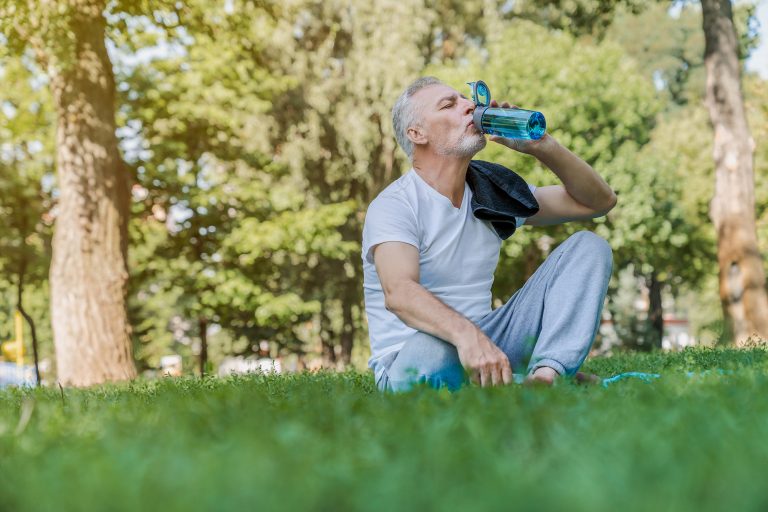
It’s the conundrum of growing older. In our minds, we feel 25, but our bodies know the truth. If you’re on the other side of 65, you’ve no doubt noticed you aren’t as strong as you once were. Or as flexible. In this phase of life, it’s critical to keep these faculties, as well as your capacity for endurance and balance, in the best shape possible. These, after all, are the keys to maintaining independence.
In this article, we’ll focus on the top 6 lower body and upper body strength exercises for seniors as well as noting a few that are best left to younger fitness enthusiasts.
Why Strength Exercises Matter for Seniors
You’ve heard the old adage, Use it or lose it. It’s especially true of our strength as we age. Gone are the days of being naturally strong. Now it takes work, or strength training to be more specific. Building up your body strength is your best defense against falls, and the best way to improve your ability to get up out of bed or a chair and also help yourself off the floor or ground if you do have a fall.
In fact, aging experts use the ability to get up off the floor and out of a chair, all without using your hands in any way, as indicators of longevity. Strength is also important for managing other activities of daily living on your own, such as bathing, toileting, dressing, cooking and eating.
And there’s no age limit on strength training being effective. According to a report published by the Department of Occupational Therapy at Indiana University, “Older adults seem to benefit from this type of exercise even at the age of 80, and even with some type of health condition.”
6 Strength Exercises for Older Adults
Be sure to talk to your doctor and/or rehabilitation specialist about your exercise intentions before you begin a fitness regimen to understand what precautions you might need to take based on your current health status, medical limitations and medications.
The following 6 exercises are excellent for improving lower body and upper body strength. They can all be done on a daily basis at home.
You’ll need:
- Exercise mat
- Sturdy chair
- Comfortable shoes and clothing
- Access to a blank wall
- Water to hydrate between exercises
Lying Hip Bridges
- Lie flat on your back on a mat with your knees bent and your feet flat on the floor.
- Flatten your lower back across the floor, squeeze your butt, and gently push your hips up into the air.
- Keep both feet firmly planted on the floor.
- Pause, then slowly lower yourself back to the starting position.
- Increase repetitions as your body allows.
Wall Pushups
- Using a wall free of furniture, artwork, etc. stand a little farther than arm’s length away.
- Facing the wall, lean your body forward, and place your palms flat against the wall at about shoulder-length and shoulder-width apart.
- Bend your elbows as you lower your upper body toward the wall slowly. Count to five while keeping your feet firmly in place.
- Pause, then slowly push yourself back until your arms are straight once again.
- Repeat these moves up to 10 times, or as many as feel challenging.
Chair Planks
- Place the back of a sturdy chair against a wall with the seat facing you.
- Stand facing the chair and place the heels of your hands toward the outside edge of the seat near the front 2 corners.
- Slowly walk your feet backward until your body forms a straight line from the head and shoulders to your feet and then pull your heels together.
- Hold this position for as long as you can, focusing on the feeling of drawing your stomach upward toward your spinal column.
- Next, slowly walk your legs back toward the chair until you can stand upright. Rest for a few minutes and try to work your way up to 3 to 5 sets.
Toe Stands
- Start by standing with your feet shoulder-width apart near a counter or chair you can use for support.
- Slowly push your heels up as far as you can go onto the balls of your feet as you count to 5. Try to hold this position for 2 to 5 seconds.
- Then, lower your heels slowly back to the floor as you count to 5, where you’ll find yourself flat on your feet.
Chair Squats
- Start by standing directly in front of a sturdy chair.
- Place your feet slightly wider than shoulder-width apart and extend your arms to be parallel to the ground.
- As you count to 5, carefully bend your knees as you slowly lower yourself toward the chair, making sure your knees do not extend beyond your toes.
- While the chair is there to catch you if you need it, try not to sit down simply hover over the seat.
- Pause. Then slowly rise back up to a standing position as you count to 3, and then repeat.
Dead Bugs
- Using your mat, lie flat on your back with your arms and legs up in the air, your knees bent.
- Press the small of your lower back into the floor.
- While keeping your core tight and knees bent, lower one leg toward the floor and the opposite arm behind you.
- Pause; then lift them back up to the starting position.
- Repeat with the opposite arm and leg as many times as your body allows without pain or straining.
Want to Test Your Fitness Age?
Before you begin your new exercise regimen, try these 6 fitness age tests to assess your current fitness age. Mark down your scores and then re-test yourself every month or so to see how you’ve improved as you become stronger!
Final Tips to Help You Succeed with Strength Training and Avoid Injury
- Not every strength exercise is a good fit for older adults. A few to avoid after 65 include:
- X – Lifting weights that put you underneath the weight equipment
- X – Moves that put weight behind your head or neck
- X – Deep squats/knee bends (instead, do chair squats described above)
- X – Crunches/Sit-Ups (instead do the plank described above)
- It’s a good idea, at least at the outset, to have a trainer or physical therapist develop a personalized plan that’s safe for your needs and that you’ll enjoy sticking with. It should include strength exercises, as well as exercises for building endurance, balance and flexibility.
- Consider getting in a wearable fitness tracker to monitor your heart rate, steps and progress.
- Talk to your trainer about how to incorporate resistance bands (link to the resistance band blog) and light hand weights and/or leg weights for a greater challenge as you progress.
Live in a Community that Celebrates Independence
You have so many plans and things you want to do to enjoy every day. As a resident of Fellowship Village or a Fellowship Freedom Plan member, our activities, wellness programs, amenities, and network of support are all designed to encourage an independent, full life. Learn more, and then contact us to see how moving to a FellowshipLIFE community might just be your very best move!




